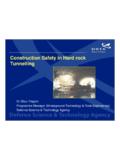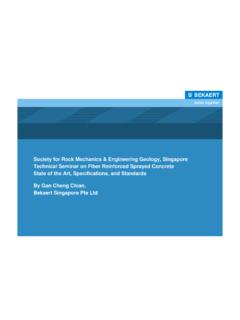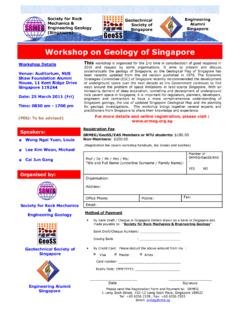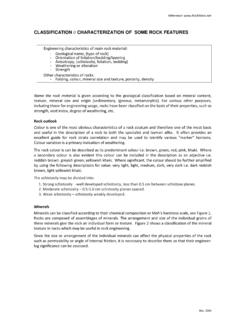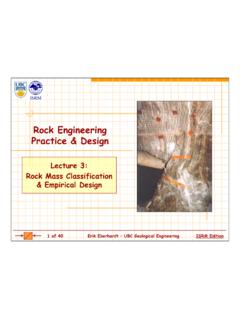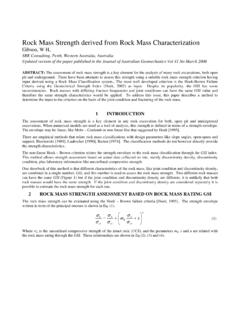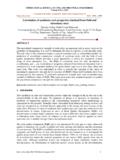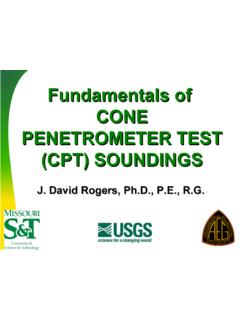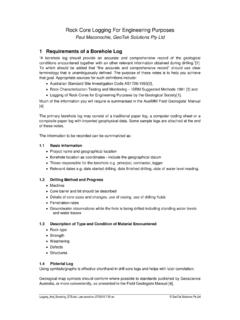Transcription of Geology of Singapore - SRMEG
1 TriTechGeology of Singapore Tritech Consultants Pte LtdJuly 2012Dr Cai Jun GangGeotechnical Engineering Appreciation Course(Jointly organised by IES Academy and GeoSS)TriTech1. some Concepts in Geology & Significance of Geology in Civil Engineering2. Recent Geological & Deep Rock Investigations3. Singapore & Adjacent Geology4. Geological Setting of Singapore5. Features of Singapore s Geological Formations6. Description of Singapore s Rocks & Soils for Civil Engineering Practice in Singapore7. Weathering Classification of Singapore s Rocks for Civil Engineering Practice in Singapore8. Updated Geological Maps & Report - 2ndEdition, DSTA (2009)TopicsTriTechSome Concepts in GeologyTriTechSome Concepts in Geology Earthis an active planet in a constant state of change. Earth movementsare vital to the cycles. Without them the land would be eroded down to just below sea level. Plate tectonicsprovide the mechanisms for all earth movements.
2 The hot interior of the earth is the ultimate energy engine driving all geologic processes. Geologic processesmodify the earth s surface, destroy old rocks, create new rocks, and add complexity to ground conditions. Geologic timesare in millions of years. The earth is 4,500 million years old. Most rocksencountered by civil engineers are 10 - 500 million years old. They have often been deformed, faulted, weathered, and eroded over many millions of years. Most surface landformsvisible today have been carved out by erosion within the last few million years. Sediments from rock destruction, weathering, and decomposition Rivers major highways transporting new sediments Seabed where much new sediments are deposited Earth s crust where rocks are created and Geological ProcessesWeatheringRocks outcrop to surfaceEarth MovementIgneous RocksMagmaMeltingMetamorphic RocksSedimentary RocksMetamorphismLithificationTransportD epositionErosionSeasoils & sedimentsTriTechSignificance of Geology in Civil Engineering Civil engineering works all carried out ON (building foundation) or IN (excavation & tunneling)the ground.
3 Interaction between Ground and Civil Works Geological formations, geological structures, strength of rocks and soils, and deformation/displacement of rocks and soils may result in Stableor Unstable Ground. Site Investigation where civil engineers encounter Geology and get to interpret ground conditions - often from minimal evidence. Unforeseen geologic conditions can still occur as ground Geology can be almost infinitely variable. They are often unforeseen due to Inadequate Site Investigation. Civil engineering designshall accommodate geologic conditions which are correctly assessed and understood as the best geological knowledge obtained in site presentsuncertainties and complexities which continually pose challenges to civil riskis the first riskfaced by civil engineersTriTechRecent Geological & Deep Rock Investigations for Rock Cavern Construction in the Bukit Timah Granite (Econ), Sponsored by NSTB, Studied By NTU, Characterization of Bukit Timah Granite for Rock Cavern Construction (Econ) , Funded by LEO (DSTA) of MINDEF, Studied by NTU and Singapore Technologies Construction (Pte) Ltd, Investigation of Hot Spring at Sembawang, Funded by Faser and Neave ( Singapore ), Studied By Zhao Jian and Chen CN, Investigations for Rock Cavern Construction in the Jurong Formation (S&F), Sponsored by NSTB, Studied By NTU & PWD, Investigations for Underground Science City at Kent Ridge (S&F)
4 , Sponsored by NSTB, Studied By NTU & PWD & JTC, Investigations for Underground Oil/Gas Storage Rock Caverns at Jurong Island (Tritech), Sponsored by NSTB, Studied By NTU, Investigations for Proposed Development of Hydrocarbon Caverns Storage in JurongIsland (Tritech) - Phase II-Feasibility Study, Funded ed by JTC, Studied by NTU & Geostock, Geologic Investigations at Banyan Basin for Development of Hydrocarbon Caverns in Jurong Island (Tritech), Flex I and Flex II Study, Jurong Island, Geostock/JCPL, 2006 Investigations at West of Jurong island (Tritech), Funded by JTC, Studied by Tritech, investigation at Kent Ridge for USC Detailed Feasibility Study (S&F), funded by investigation at Jurong Hill for Feasibility Study for Underground Warehouse recent geologic findings in building & infrastructure construction projects, tunneling & excavation of new MRT deep geological exploration to cover west and north-east areas is going on by the Geologic Office of BCA.
5 Recent Deep Rock Investigations (20 Years)TriTechLayout of Recent Rock Investigations with Seismic Exploration and Deep BoreholesTriTechTriTechSingapore & Adjacent Geology TriTechSingapore & Adjacent GeologyBackgroundOur Geology is closely related to that of Peninsular Malaysia. Johor has rocks identical to our gabbroic and noriticrocks of the Gombak Norite; our granitic rocks of the Bukit Timah Granite; our sedimentary rocks of the Palaeozoic Volcanics, Sajahat Formation, and JurongFormation; and our thick deposit of sand and gravel of the Old by Michael LeeTriTechGeological Setting of SingaporeTriTech1245 Geologic Setting of SingaporeSingapore s natural deposits are classified under 10 geological formations. In decreasing age, they are outlined with their characteristic rock or sediment Sajahat Formation: quartzite, argillite2. Gombak norite: norite and gabbro3. Palaeozoic Volcanics: tuff4. Bukit Timah Granite: granite5.
6 Jurong Formation: reddish mudstone, grey fossil-rich mudstone and shale, fossil-rich limestone, siltstone, sandstone, conglomerate6. Fort Canning Boulder Bed: hard red and white sandy silty clay containing many sandstone boulders7. Old Alluvium: dense muddy sand/gravel8. Huat Choe Formation: firm white kaolin clay9. Tekong Formation: loose pebbly sand10. Kallang Formation: soft grey clay, loose brownish muddy sand, loose light grey to white sand, peaty Setting of Major FormationsFormationAgeMaterialDistributi onBedrock formationsSajahat Formation Early Palaeozoic(540 445 my)quartzite, argilliteP. Tekong, P. Sajahat, PunggolGombak NoriteEarly Palaeozoic(540 445 my)Norite, gabbroBt. Gombak, Bt. Panjang, and adjacent hillsBukit TimahGraniteEarly to Middle Triassic (250 235 my)granite, granodiorite, adamellite, dioritecentral Singapore IslandJurong FormationLate Triassic to Early Jurassic (235 175 my)red purplish mudstone and sandstone, grey fossil-rich mudstone and shale, siltstone, conglomerate, fossil-rich limestonewest and southwest Singapore Island and southern islandsWeak rock/Soil formationsFort Canning Boulder BedLate Cretaceous(100 65 my)hard, often red and white, unstratified sandy silty clay containing many big lens-shaped to rounded fresh sandstonecentral business districtOld Alluvium Late Tertiary to Middle Pleistocene(5 my)dense to cemented muddy sand/gravel with beds of silt and/or clayeast SingaporeKallang FormationLate Pleistocene to Present( 0 my)
7 Soft marine clay, loose alluvial muddy sand, loose beach sand, soft peaty and organic mud, and river valleys and mouthsFrom Old to YoungTriTechMajor Fault StructuresTriTechSea levelSajahat FormationPalaeozoic VolcanicsGombak NoriteAcid magma for Bukit TimahGraniteAcid magma for Main Range GraniteAcid magma from great depths rose during the Late Palaeozoic (360 250 my)Historical Geologic SettingPre-palaezoic rocks TriTechHistorical Geologic Settingsea levelJurong FormationUplift of the Main Range Granite and the Bukit TimahGranite created a shallow basin for the deposition of the Jurong Formation during Early Triassic to Early Jurassic (235 175 my)Bukit Timah GraniteMain Range GraniteTriTechsea levelOld AlluviumHistorical Geologic SettingAfter Early Jurassic (175 my), uplift was minimal and much of the land mass was above sea level and marine sedimentation ceased. Alluvial sediments of the Old Alluvium were deposited in a deep faulted trough during Late Tertiary to Middle Pleistocene (5 to my)Bukit Timah GraniteMain Range GraniteTriTechHistorical Geologic SettingMarine MemberReef MemberLittoral MemberAlluvial MemberTekong FormationTransitional MemberRepresenting the youngest natural deposits, the high-level beach sand of the Tekong Formation were deposited about 5000 to 6000 year ago in Holocene times and the marine clay, coral sand, beach sand, alluvial muddy sand, and peaty clay of the Kallang Formation continues to be deposited in present times since the Late Pleistocene (140,000 years to Present).
8 Bukit Timah GraniteMain Range GraniteTriTechSeaBt TimahBt GombakChangi VillageJurongTuasKallangPunggolSeaSimpli fied Singapore Geological Section Bukit Timah Granite (Base)Gombak NoriteSajahat FormationJurong FormationOld AlluviumKallang Formationfrom Tuas (West) to Changi (East) TriTechThere are about 25 hilly areas with elevation above 40m in the Bukit Timah area. All abandoned and operating quarries are located on one of the 25 hilly areas. There are 15 hilly areas with elevation above 40m in the Jurong area. Topographic Feature - Hilly Areas in Relation to Singapore RocksThe advantages of constructing caverns at these hilly areas include: The hilly areas usually have shallow overburdens, shallow bedrock depths, and good quality rock mass. Only horizontal tunnel access or inclined tunnel access are required, resulting in a much lower construction costTriTechBT Granite area has 25 hills above +40m elevation (yellow shade)Jurong Formation area has 15 hilly area above +40m (yellow shade) Geographic feature - Hilly Areas in Relation to Singapore RocksTriTechFeatures of Singapore s Geological FormationsTriTechRocks: predominantly granite; less common are granodiorite, adamellite, and dioriteMineralogy: quartz (30%), feldspar (60-65%), biotite, and hornblende (less than 10%)Texture: medium to coarse grained, light grey but sometimes pinkishAge: Early to Middle Triassic (250 235 my)Bukit Timah GraniteGeneralTriTechTypical Outcrops of Bukit Timah GraniteTriTechDistributionIt underlies about a third of Singapore Island and the whole of P.
9 Ubin. It is recognised as the base rock as it underlies all other was originally formed from a large body of acidic magma which intruded from great depths into the Gombak Norite and other older formations such as the Sajahat Formation and Palaeozoic Volcanics. The older rocks were eventually removed by erosion and the Bukit Timah Granite is Timah GraniteTriTechWeathering and Bedrock ProfileWeathering: very extensive through mineral decomposition; depth varies from a few to 80 m with a commonly occurring depth about 25 m. Profile: tropical humid soil profile is characteristic; an undulating rock surface with a sharp change from residual soil to granite is usually observed; large boulders are sometimes Timah GraniteTriTechStrength and ModulusCompressive: very high; fresh material has average UCS of 160 MPa with the highest value in excess of over 300 MPa; weathered materials have much lower strengthModulus:average of 70 GPa.
10 Tensile:about a tenth of UCS valuesCriterion:Mohr-Coulomb at low stress level; best with Hoek-Brown criterion (mi = 30 - 33).Bukit Timah GraniteTriTechJointing and Rock MassJointing:4 to 5 joint sets; dominant one is sub-vertical with a NNW-SSE strikeJoint Surface: usually rough and little weatheredShear Strength: shear friction angle varying with smoothjoints having angles of about 30 degrees and rough joints up to 70 degreesRock Mass:usually good and above-good qualityBukit Timah GraniteTriTechGroundwater and StressPermeability: very low within the range of 10-7to 10-9m/s,; As the granite rock mass is quite impermeable, groundwater flow is only likely in fractured zones and faultsSprings:large groundwater flow and springs can befound in fault zones ( , Sembawang hot spring)In-situStresses:high in-situ horizontal stress (about 2 - 3 times vertical stress) in a NNE-SSW directionBukit Timah GraniteTriTechDistribution:western and southwestern Singapore Island and the southern islands.
